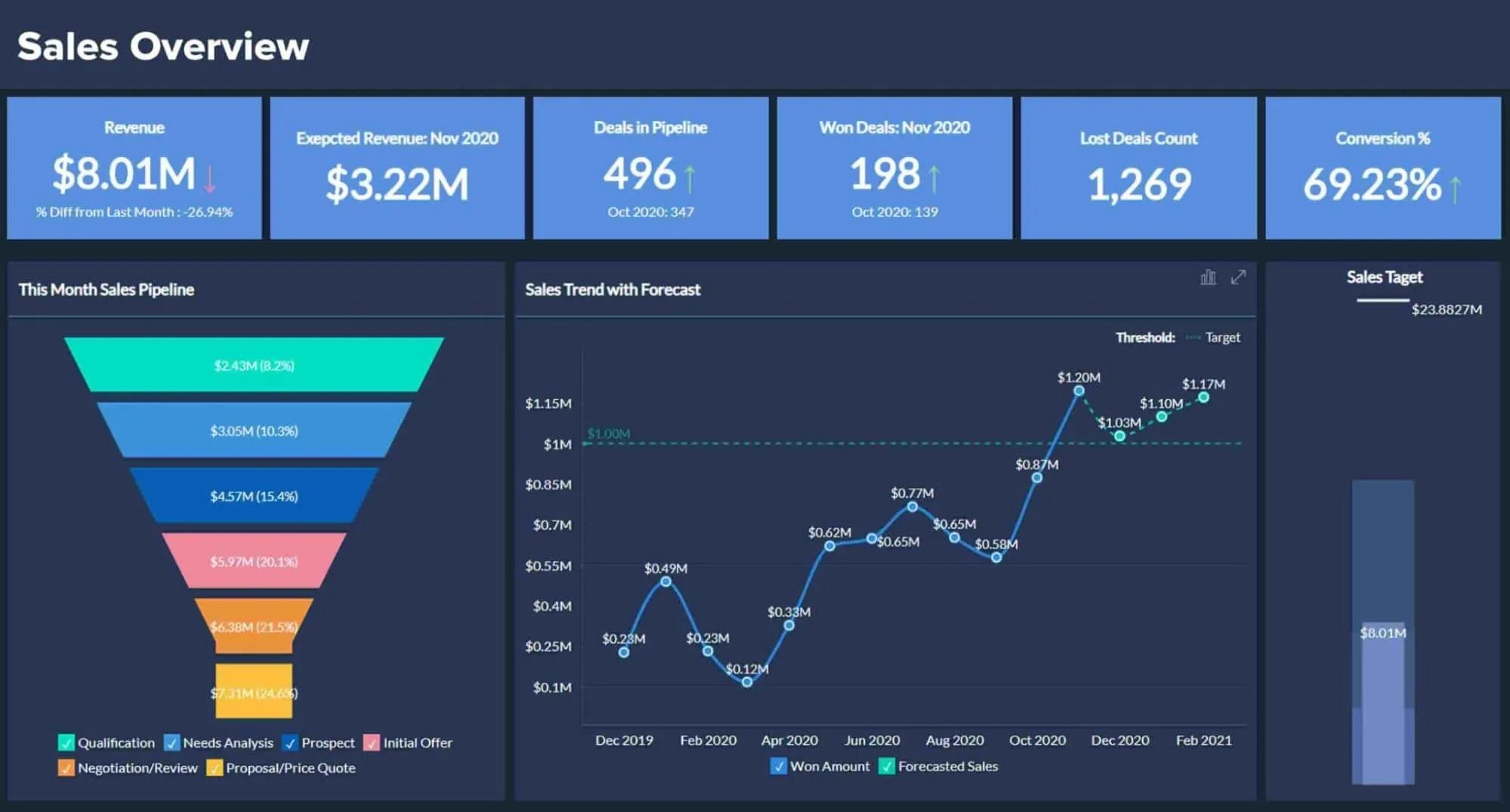A HubSpot and Salesforce Comparison in 2025
HubSpot and Salesforce are like the dynamic duo of sales and marketing CRMs.

HubSpot offers a treasure trove of data right at your fingertips, presenting both opportunities and challenges for businesses. It's all too easy to get overwhelmed by the sheer volume of information available and struggle to pinpoint the metrics that truly impact your bottom line.
With a plethora of HubSpot metrics at their disposal, sales teams have a wealth of insights to leverage across all Hubs. The key is to avoid drowning in a sea of reports and focus on what truly drives leads and closes sales.
Having delved deep into HubSpot's sales data, we've dialled in on the metrics that matter most to our customers. While every business is unique and may require additional specific metrics, we're confident these top ten KPIs serve as a solid foundation for nearly every ambitious business striving for success.
If you're new to working with Sales metrics, check out this concise definition from Gartner.

Let's get into it -
Sales ultimately revolve around revenue, making it a crucial metric to monitor. There are various ways to dissect revenue;
Annual Contract Value is the amount of revenue a contract generates per year. Like LTV, it's important to track it so you have clarity on what contracts drive the highest value each year.
Tracking the Average Customer Lifetime Value (LTV) is crucial for sales teams as it provides insight into the revenue potential each customer holds throughout their relationship with your company. This metric not only helps in understanding the true Return on Investment (ROI) from each customer but also enables the identification of high-value customer segments. By pinpointing commonalities among customers with a high lifetime value, your sales team can effectively target similar businesses or prospects to drive success.
Monitoring Monthly Recurring Revenue (MRR) provides a valuable insight into the consistent revenue your company anticipates each month. This metric, much like Annual Contract Value (ACV), allows you to pinpoint which clients are driving revenue on a monthly basis.
While this metric is particularly beneficial for businesses with monthly billing cycles, it also holds significance for eCommerce companies looking to track customer retention and frequency of orders.
Determining Customer Acquisition Cost (CAC) is a pivotal metric that sheds light on the average expenses involved in securing a new customer through sales and marketing efforts. While HubSpot doesn't automatically crunch these numbers for you, it does equip you with the necessary data to accurately calculate your CAC.
By dividing your total sales and marketing expenses by the number of customers acquired within a specific timeframe, you can gain valuable insights into the investment required to acquire each new customer. This metric is paramount in assessing the effectiveness of your sales and marketing strategies in attracting valuable customers to your business.
Forecast Accuracy is driven by two essential techniques- Qualification and Standardisation. HubSpot is an excellent tool to leverage both these techniques and drive forecast accuracy.
With forecast accuracy tracking, you can measure the reliability of your forecasts and the effectiveness of your forecasting process. Accurate forecasts can help you identify trends and improve the performance of your forecasts so managers can coach reps and reps can gain more visibility into their performance.
No matter what size your business is, It's vital to have a holistic overview of your entire pipeline so you can quickly and easily dive into the details with your team and ensure you maintain highly accurate forecasting.
Understanding the duration it takes for leads to navigate the sales pipeline until securing a closed-won deal is a vital metric for not only your sales team but also your marketing, customer service, and management teams. By pinpointing the length of your sales cycle, you can effectively strategise marketing efforts, touch-points, and follow-ups.
Furthermore, tracking your sales cycle aids in revenue monitoring - a lengthier sales cycle necessitates a heightened awareness of the timeframe between lead entry into the system and their eventual purchase.
8. Win rate
![]() Win rate, calculated by dividing the number of deals won by the total number of deals, offers valuable insights into your sales team's performance and individual capacities. Monitoring this metric is crucial for understanding how effectively your team is closing deals and maximising their potential.
Win rate, calculated by dividing the number of deals won by the total number of deals, offers valuable insights into your sales team's performance and individual capacities. Monitoring this metric is crucial for understanding how effectively your team is closing deals and maximising their potential.
Monitoring the average lead response time is a crucial metric for evaluating sales performance. It provides insight into how quickly your sales team follows up with leads.
Identifying areas with prolonged response times can highlight the need for implementing automated email sequences to ensure prompt follow-ups. It may also indicate the necessity of expanding your sales team to effectively manage the influx of leads.
Year-over-year (YoY) growth is the metric that compares revenue generated from year to year.
Calculate YoY Growth using:
YoY Growth = ((Current Year Metric - Previous Year Metric) / Previous Year Metric) * 100
For instance, if your company generated 6,000,000 in revenue in 2022 and 7,200,000 in 2023, achieving a 20% Year-over-Year (YoY) growth in revenue from 2023 to 2023 is a significant milestone.
The reason to track and monitor this metric: YoY Growth serves as a valuable metric for assessing your company's overall performance and success in expanding its business and achieving its objectives.
Let's make room for one more ....
Net Promoter Score (NPS) reflects whether a customer would recommend your business to another person. Generally, you calculate this by asking contacts, "On a scale of 1-10, how likely are you to recommend us to a friend or colleague?"
Customer Satisfaction Score (CSAT) measures customer satisfaction with a business, purchase, or interaction. It’s one of the most straightforward ways to measure customer satisfaction, and it's obtained by asking a simple question, such as 'How satisfied were you with your experience?'
To answer, there's a corresponding survey scale, which can be 1 – 3, 1 – 5, or 1 – 10.
 It's common for organisations to use one or both of these metrics.
It's common for organisations to use one or both of these metrics.
Understanding the pulse of your customer base is crucial, as satisfied customers represent a valuable source for potential future clients. Conversely, dissatisfied customers can lead to lost opportunities.
For your sales team, it's essential to grasp both scenarios. Happy, loyal customers can be leveraged for networking and acquiring new leads while addressing the concerns of unhappy customers presents an opportunity to collaborate with your customer service team and make necessary improvements.
Navigating the intricate maze of metrics within HubSpot can be challenging. One effective strategy to streamline this process is to collaborate with a proven partner that excels in dissecting data and transforming it into comprehensive reports. By doing so, you'll have all the essential information readily available in one convenient location, making it easier for you to access everything you need.
If you'd like to talk about using HubSpot in your business, use this link to set up an obligation free chat with us
Consolidated sales metrics can be difficult to obtain especially when your B2B contracted customers place orders in a separate system from non contracted customers. Solving this usually involves spreadsheets or visualisation tools like BI.
This can be eliminated by integrating an eCommerce solution that is natively hosted in HubSpot on your website with customer portals for contracted customers with full CPQ.
One of the core issues for our professional development clients is minimising the loss of billable time for key resources associated with business development.
Measuring the ratio of non-billable time allocated to business development creates a time-phased Sales Metric that can be measured and managed.
Identifying ready to buy clients is key to this balance and we discuss it in detail in this article.
A booking is the promise to deliver and billing is when that promise is fulfilled.
Bookings can also be called Sales, Orders or Sales Orders.
Revenue can only be financially recognised when billed, and many professional services firms can recognise un-billed accounts receivable to capture the true state of the P&L.

HubSpot and Salesforce are like the dynamic duo of sales and marketing CRMs.

Businesses wanting to make more sales, expand their operations and supercharge their revenues look to the powerful combination of sales and...